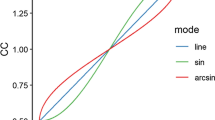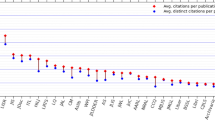Abstract
Traditional bibliometric indicators aim at helping academic administrators or research investors measure the influence of publications. These indicators focus on how to quantify and compare the scientific output of researchers. However, little attention has been paid to the aspect that bibliometric indicators can also be used to help scientists find valuable referential papers. In this paper, we propose three points to characterize valuable referential papers: first, valuable referential papers always are high-quality research; second, valuable referential papers are closely related to a considerable quantity of recent papers; third, valuable referential papers lead to hotspots which attract papers to follow successively. We extract the critical subnetwork from the original citation network which only reserves the significant nodes and edges that meet the three preceding points. Then we present two indicators on the basis of the critical subnetwork. The experimental results demonstrate that papers recommended by our indicators are relatively new and our indicators have greater Spearman’s rank correlation coefficients with the future citation count compared with other bibliometric indicators like the raw citation count.






Similar content being viewed by others
References
Abramo, G., Costa, C., & D’Angelo, C. A. (2015). A multivariate stochastic model to assess research performance. Scientometrics, 102(2), 1755–1772. doi:10.1007/s11192-014-1474-5.
Adam, D. (2002). Citation analysis: The counting house. Nature, 415(6873), 726–729.
Adie, E., & Roe, W. (2013). Altmetric: Enriching scholarly content with article-level discussion and metrics. Learned Publishing, 26(1), 11. doi:10.1087/20130103.
Beel, J., & Gipp, B. Google Scholar’s ranking algorithm: The impact of citation counts (an empirical study). In Research challenges in information science, 2009. RCIS 2009. Third international conference on IEEE, 2009 (pp. 439–446).
Braun, T., Glanzel, W., & Schubert, A. (2006). A Hirsch-type index for journals. Scientometrics, 69(1), 169–173. doi:10.1007/s11192-006-0147-4.
Chen, P., Xie, H., Maslov, S., & Redner, S. (2007). Finding scientific gems with Google’s PageRank algorithm. Journal of Informetrics, 1(1), 8–15. doi:10.1016/j.joi.2006.06.001.
Davis, P. M. (2008). Eigenfactor: Does the principle of repeated improvement result in better estimates than raw citation counts? Journal of the American Society for Information Science and Technology, 59(13), 2186–2188. doi:10.1002/asi.20943.
Egghe, L. (2006). Theory and practise of the g-index. Scientometrics, 69(1), 131–152. doi:10.1007/s11192-006-0144-7.
Franceschini, F., Galetto, M., Maisano, D., & Mastrogiacomo, L. (2012). The success-index: An alternative approach to the h-index for evaluating an individual’s research output. Scientometrics, 92(3), 621–641. doi:10.1007/s11192-011-0570-z.
Hirsch, J. E. (2005). An index to quantify an individual’s scientific research output. Proceedings of the National Academy of Sciences of the United States of America, 102(46), 16569–16572. doi:10.1073/pnas.0507655102.
Hirsch, J. E. (2007). Does the h index have predictive power? Proceedings of the National Academy of Sciences of the United States of America, 104(49), 19193–19198. doi:10.1073/pnas.0707962104.
Ho, Y. S. (2004). Citation review of Lagergren kinetic rate equation on adsorption reactions. Scientometrics, 59(1), 171–177.
Ibanez, A., Larranaga, P., & Bielza, C. (2009). Predicting citation count of bioinformatics papers within 4 years of publication. Bioinformatics, 25(24), 3303–3309. doi:10.1093/bioinformatics/btp585.
Jin, B. H., Liang, L. M., Rousseau, R., & Egghe, L. (2007). The R- and AR-indices: Complementing the h-index. Chinese Science Bulletin, 52(6), 855–863. doi:10.1007/s11434-007-0145-9.
Lundberg, J. (2007). Lifting the crown-citation z-score. Journal of Informetrics, 1(2), 145–154. doi:10.1016/j.joi.2006.09.007.
MacRoberts, M. H., & MacRoberts, B. R. (1996). Problems of citation analysis. Scientometrics, 36(3), 435–444. doi:10.1007/Bf02129604.
MacRoberts, M. H., & MacRoberts, B. R. (2010). Problems of citation analysis: A study of uncited and seldom-cited influences. Journal of the American Society for Information Science and Technology, 61(1), 1–12. doi:10.1002/asi.21228.
Price, D. J. D. (1965). Networks of scientific papers. Science, 149(3683), 510.
Schubert, A., & Braun, T. (1986). Relative indicators and relational charts for comparative-assessment of publication output and citation impact. Scientometrics, 9(5–6), 281–291. doi:10.1007/Bf02017249.
Seglen, P. O. (1997). Citations and journal impact factors: Questionable indicators of research quality. Allergy, 52(11), 1050–1056.
Senanayake, U., Piraveenan, M., & Zomaya, A. (2015). The pagerank-index: Going beyond citation counts in quantifying scientific impact of researchers. PLoS One, 10(8), 222–229. doi:10.1371/journal.pone.0134794.
Shibata, N., Kajikawa, Y., & Sakata, I. (2012). Link prediction in citation networks. Journal of the American Society for Information Science and Technology, 63(1), 78–85.
Thorne, F. C. (1977). Citation index—another case of spurious validity. Journal of Clinical Psychology, 33(4), 1157–1161. doi:10.1002/1097-4679(197710)33:4<1157:Aid-Jclp2270330453>3.0.Co;2-B.
Van Raan, A. F. J. (1996). Advanced bibliometric methods as quantitative core of peer review based evaluation and foresight exercises. Scientometrics, 36(3), 397–420.
Van Raan, A. F. J. (2006). Comparison of the Hirsch-index with standard bibliometric indicators and with peer judgment for 147 chemistry research groups. Scientometrics, 67(3), 491–502. doi:10.1556/Scient.67.2006.3.10.
Waltman, L., Costas, R., & Jan van Eck, N. (2012). Some limitations of the h index: A commentary on Ruscio and colleagues’ analysis of bibliometric indices. Measurement: Interdisciplinary Research and Perspectives, 10(3), 172–175.
Waltman, L., van Eck, N. J., van Leeuwen, T. N., Visser, M. S., & van Raan, A. F. J. (2011). Towards a new crown indicator: Some theoretical considerations. Journal of Informetrics, 5(1), 37–47. doi:10.1016/j.joi.2010.08.001.
Acknowledgments
This work was jointly supported by the National Natural Science Foundation of China (Grant nos. 61173111 and 60774086) and the Ph.D. Programs Foundation of Ministry of Education of China (Grant no. 20090201110027).
Author information
Authors and Affiliations
Corresponding author
Ethics declarations
Conflict of interest
None.
Rights and permissions
About this article
Cite this article
Li, Z., Peng, Q. & Liu, C. Two citation-based indicators to measure latent referential value of papers. Scientometrics 108, 1299–1313 (2016). https://doi.org/10.1007/s11192-016-2000-8
Received:
Published:
Issue Date:
DOI: https://doi.org/10.1007/s11192-016-2000-8




